Overview
- Brief Narrative
- Original design for a coat created by Julius Isaacsohn, a Jewish designer with his own garment making business in prewar Berlin, Germany. In 1938, Julius and his wife Gertrud, a dressmaker with her own business, had lost their livelihood because of the anti-Semitic policies of the Nazi regime. They sent their daughter Dorit, age 6, to Brussels, Belgium, in early 1939, to stay with Gertrud’s sister Anna Kaufman. Germany invaded Belgium in May 1940, and Gertrud and Julius had Dorit returned to them in 1941. Gertrud and Julius became forced laborers for the German government, working in a leather factory and lumber yard respectively. On February 27, 1943, the family had to separate in order to go into hiding. Julius and Dorit stayed with family friends and Julius’ nephew, Rolf Isaacsohn, in Berlin, while Gertrud began working as a traveling seamstress. In October 1943, Gertrud brought Dorit to live with her on a farm in Wilkersdorf. Shortly after, Julius, who was hiding with friends, was betrayed to the authorities by Rolf. On October 29, Julius was deported to Auschwitz-Birkenau killing center in German-occupied Poland, where he was killed. Gertrud and Dorit traveled around eastern Germany making dresses for private clients until January 1945, when they were liberated by Soviet forces in Wilkersdorf. Gertrud and Dorit immigrated to the United States in November 1949.
- Title
- Ulla
- Date
-
creation:
1930-1943
- Geography
-
creation:
Berlin (Germany)
- Credit Line
- United States Holocaust Memorial Museum Collection, Gift of Dorit Isaacsohn
- Markings
- front, top right corner, handwritten, pencil : Ulla
- Contributor
-
Subject:
Julius Isaacsohn
Designer: Julius Isaacsohn
- Biography
-
Julius Isaacsohn was born on November 19, 1891, in Berlin, Germany, to Herrman Benjamin and Ernestine Kaiser Isaacsohn. He had several brothers. Julius was a garment maker and coat and suit designer who imported his own fabrics. In May 1931, Julius married Gertrud Koh, a master seamstress. She was born on June 3, 1901, in Gratz, Germany (Grodzisk Wielkopolski, Poland), to Alex and Dorothea Koh. She had 2 brothers, and a sister, Anna, and the family moved to Berlin after World War I. Gertrud ran a dressmaking business in their apartment and employed a non-Jewish woman, Lucie Gardner. On July 15, 1933, Julius and Gertrud’s daughter, Dorothea (Dorit,) was born. They made a good living, lived in a predominantly Jewish area, and attended a large synagogue.
The Nazi regime took power in 1933, and began actively persecuting Jews. Gertrud’s employee Lucie was not allowed to work for a Jewish woman. In 1938, Julius and Gertrud lost their jobs. In February 1939, they had to turn over their valuables. Julius and Gertrud attempted to leave Germany, but could not get visas. They sent 6 year old Dorit to Brussels, Belgium, to live with Gertrud’s sister, Anna Kaufman. She, her husband, and stepson had fled to Brussels earlier because Anna’s stepson was gay and was persecuted by the Nazis. Dorit had diphtheria when she arrived and was hospitalized before going to live with her aunt Anna. Julius and Gertrud were forced to house displaced Jewish families in their apartment. The war began when Germany invaded Poland on September 1, 1939. Shortly after, on May 10, 1940, Germany invaded Belgium. A year later, Julius and Gertrud had Dorit returned to Berlin with the help of a family friend. Julius and Gertrud became forced laborers for the German government: Julius at a lumber yard, and Gertrud at a Kurt Seidel factory sewing leather goods for the army. They began making arrangements to go into hiding.
On February 27, 1943, Gertrud heard that there was going to be a large roundup of Jews so the family went into hiding with non-Jewish friends. Julius and Gertrud found an apartment to rent under the false name Schultz, but they had no papers to support that claim. When they arrived, the owner refused to let them stay and they separated. They sent Dorit to stay with her mother’s former employee, Lucie Gardner, who told neighbors that Dorit was her niece. Julius went to stay in the basement apartment of a janitor, where he slept in a rocking chair. Gertrud put an ad in the paper advertising herself as a private, traveling dressmaker who had been bombed out of her apartment and was looking for work in people’s homes. She told people that her husband was in the army and her daughter was with family. In April or May, Dorit moved into a crowded apartment with Julius’ nephew Rolf Isaacsohn, and his girlfriend, Stella Goldschlag Kubler. In July, Rolf and Dorit learned that Stella had been arrested by the Gestapo. Shortly after, Dorit went to live with Julius in the janitor’s apartment.
In October 1943, Gertrud was living at a farm in Wilkersdorf (Krzesnica, Poland) and asked the farmer to allow Dorit to live there. The farmer agreed if Dorit brought stamps for sugar. Julius purchased the stamps on the black market and Dorit moved to the farm. In November, Rolf asked Julius to meet him. Several friends warned Julius that Rolf and Stella were turning Jews over to the Gestapo, but Julius believed his nephew would never hurt him. Julius went to meet Rolf and was arrested by the Gestapo. On October 29, 1943, Julius was placed on Transport 45 and deported to Auschwitz-Birkenau killing center in German-occupied Poland, where he was killed. From November 1943 to December 1944, Gertrud and Dorit traveled around Germany working as a private dressmaker for wealthy clients. They both survived the war, and in 1949, they immigrated to the United States. Gertrud, 77, died in July 1978, in Philadelphia. Dorit, 75, died on December 5, 2008, in Philadelphia.
Physical Details
- Classification
-
Art
- Category
-
Drawings
- Object Type
-
Fashion drawings (lcsh)
- Genre/Form
- Women's clothing. Coats--Pattern design. Coats.
- Physical Description
- Original coat design sketched in pencil over a pre-printed, black ink image of a tall, slender, short haired woman depicted, front and back, on tan paper. She wears a long coat with 4 buttons at the front waist and a narrow collar with squared ends. Both lapels are edged with a line of stitches and have rounded top points, with a button on the right one. The long sleeve is full with a pointed cuff. On the back, the high collar is rolled, the waist is cinched by a 2 button band, and the center seam is highlighted with stitching. The front, left view depicts the woman winking, her head turned slightly and her right hand resting on her hip, the elbow angling outward. The back view depicts her head in quarter left profile with her arms at her sides, elbows slightly bent. The design name is handwritten at the top.
- Dimensions
- overall: Height: 11.000 inches (27.94 cm) | Width: 7.125 inches (18.098 cm)
- Materials
- overall : paper, ink, pencil
Rights & Restrictions
- Conditions on Access
- No restrictions on access
- Conditions on Use
- No restrictions on use
Keywords & Subjects
- Topical Term
- Fashion designers--Germany--Berlin--Biography. Hidden children (Holocaust)--Germany--Berlin--Biography. Holocaust survivors--United States--Biography. Holocaust, Jewish (1939-1945)--Germany--Berlin--Personal narratives. Germany--Emigration and immigration--History--20th century. United States--Emigration and immigration--History--20th century. Jews--Persecution--Germany--Biography.
- Geographic Name
- Germany. Berlin (Germany) United States. Belgium.
- Corporate Name
- Birkenau (Concentration camp)
Administrative Notes
- Legal Status
- Permanent Collection
- Provenance
- The fashion drawing was donated the United States Holocaust Memorial Museum in 2002 by Dorit Isaacsohn, the daughter of Julius and Gertrud Isaacsohn.
- Funding Note
- The cataloging of this artifact has been supported by a grant from the Conference on Jewish Material Claims Against Germany.
- Record last modified:
- 2022-07-28 18:10:36
- This page:
- https://collections.ushmm.org/search/catalog/irn513409
Download & Licensing
In-Person Research
- By Appointment
- Request 21 Days in Advance of Visit
- Plan a Research Visit
- Request to See This Object
Contact Us
Also in Dorit Isaacsohn family collection
The collection consists of fashion drawings, handmade garments, and photographs relating to the experiences of Gertrude, Julius and Dorit Isaacsohn before the Holocaust in Grätz (Grodzisk Wielkopolski, Poland) and Berlin, Germany, and after the Holocaust in Berlin and the United States.
Date: 1930-1949

Navy openwork jacket with belt made by a German Jewish woman
Object
Handmade jacket and belt designed and created by Gertrud Koh Isaacsohn, a Jewish dressmaker in prewar Berlin, Germany. In 1938, Gertrud and her husband Julius, a coat and suit designer with his own garment making business, had lost their livelihood because of the anti-Semitic policies of the Nazi regime. They sent their daughter Dorit, age 6, to Brussels, Belgium, in early 1939, to stay with Gertrud’s sister Anna Kaufman. Germany invaded Belgium in May 1940, and Gertrud and Julius had Dorit returned to them in 1941. Gertrud and Julius became forced laborers for the German government, working in a leather factory and lumber yard respectively. On February 27, 1943, the family had to separate in order to go into hiding. Gertrud began working as a traveling seamstress and Julius and Dorit stayed with family friends, and Julius’ nephew, Rolf Isaacsohn, in Berlin. In October 1943, Gertrud brought Dorit to live with her on a farm in Wilkersdorf. Shortly after, Julius, who was hiding with friends, was betrayed to the authorities by Rolf. On October 29, Julius was deported to Auschwitz-Birkenau killing center in German-occupied Poland, where he was killed. Gertrud and Dorit traveled around eastern Germany making dresses for private clients until January 1945, when they were liberated by Soviet forces in Wilkersdorf. Gertrud and Dorit immigrated to the United States in November 1949.
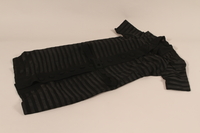
Striped black coatdress with belt made by a German Jewish woman
Object
Handmade coatdress and belt designed and created by Gertrud Koh Isaacsohn, a Jewish dressmaker in prewar Berlin, Germany. In 1938, Gertrud and her husband Julius, a coat and suit designer with his own garment making business, had lost their livelihood because of the anti-Semitic policies of the Nazi regime. They sent their daughter Dorit, age 6, to Brussels, Belgium, in early 1939, to stay with Gertrud’s sister Anna Kaufman. Germany invaded Belgium in May 1940, and Gertrud and Julius had Dorit returned to them in 1941. Gertrud and Julius became forced laborers for the German government, working in a leather factory and lumber yard respectively. On February 27, 1943, the family had to separate in order to go into hiding. Gertrud began working as a traveling seamstress and Julius and Dorit stayed with family friends, and Julius’ nephew, Rolf Isaacsohn, in Berlin. In October 1943, Gertrud brought Dorit to live with her on a farm in Wilkersdorf. Shortly after, Julius, who was hiding with friends, was betrayed to the authorities by Rolf. On October 29, Julius was deported to Auschwitz-Birkenau killing center in German-occupied Poland, where he was killed. Gertrud and Dorit traveled around eastern Germany making dresses for private clients until January 1945, when they were liberated by Soviet forces in Wilkersdorf. Gertrud and Dorit immigrated to the United States in November 1949.

Coat design, Iris, created by a German Jewish man and saved by his wife in hiding
Object
Original design for a coat created by Julius Isaacsohn, a Jewish designer with his own garment making business in prewar Berlin, Germany. In 1938, Julius and his wife Gertrud, a dressmaker with her own business, had lost their livelihood because of the anti-Semitic policies of the Nazi regime. They sent their daughter Dorit, age 6, to Brussels, Belgium, in early 1939, to stay with Gertrud’s sister Anna Kaufman. Germany invaded Belgium in May 1940, and Gertrud and Julius had Dorit returned to them in 1941. Gertrud and Julius became forced laborers for the German government, working in a leather factory and lumber yard respectively. On February 27, 1943, the family had to separate in order to go into hiding. Julius and Dorit stayed with family friends and Julius’ nephew, Rolf Isaacsohn, in Berlin, while Gertrud began working as a traveling seamstress. In October 1943, Gertrud brought Dorit to live with her on a farm in Wilkersdorf. Shortly after, Julius, who was hiding with friends, was betrayed to the authorities by Rolf. On October 29, Julius was deported to Auschwitz-Birkenau killing center in German-occupied Poland, where he was killed. Gertrud and Dorit traveled around eastern Germany making dresses for private clients until January 1945, when they were liberated by Soviet forces in Wilkersdorf. Gertrud and Dorit immigrated to the United States in November 1949.

Coat design, Görlik, created by a German Jewish man and saved by his wife in hiding
Object
Original design for a coat created by Julius Isaacsohn, a Jewish designer with his own garment making business in prewar Berlin, Germany. In 1938, Julius and his wife Gertrud, a dressmaker with her own business, had lost their livelihood because of the anti-Semitic policies of the Nazi regime. They sent their daughter Dorit, age 6, to Brussels, Belgium, in early 1939, to stay with Gertrud’s sister Anna Kaufman. Germany invaded Belgium in May 1940, and Gertrud and Julius had Dorit returned to them in 1941. Gertrud and Julius became forced laborers for the German government, working in a leather factory and lumber yard respectively. On February 27, 1943, the family had to separate in order to go into hiding. Julius and Dorit stayed with family friends and Julius’ nephew, Rolf Isaacsohn, in Berlin, while Gertrud began working as a traveling seamstress. In October 1943, Gertrud brought Dorit to live with her on a farm in Wilkersdorf. Shortly after, Julius, who was hiding with friends, was betrayed to the authorities by Rolf. On October 29, Julius was deported to Auschwitz-Birkenau killing center in German-occupied Poland, where he was killed. Gertrud and Dorit traveled around eastern Germany making dresses for private clients until January 1945, when they were liberated by Soviet forces in Wilkersdorf. Gertrud and Dorit immigrated to the United States in November 1949.

Coat design, Turin, created by a German Jewish man and saved by his wife in hiding
Object
Original design for a coat created by Julius Isaacsohn, a Jewish designer with his own garment making business in prewar Berlin, Germany. In 1938, Julius and his wife Gertrud, a dressmaker with her own business, had lost their livelihood because of the anti-Semitic policies of the Nazi regime. They sent their daughter Dorit, age 6, to Brussels, Belgium, in early 1939, to stay with Gertrud’s sister Anna Kaufman. Germany invaded Belgium in May 1940, and Gertrud and Julius had Dorit returned to them in 1941. Gertrud and Julius became forced laborers for the German government, working in a leather factory and lumber yard respectively. On February 27, 1943, the family had to separate in order to go into hiding. Julius and Dorit stayed with family friends and Julius’ nephew, Rolf Isaacsohn, in Berlin, while Gertrud began working as a traveling seamstress. In October 1943, Gertrud brought Dorit to live with her on a farm in Wilkersdorf. Shortly after, Julius, who was hiding with friends, was betrayed to the authorities by Rolf. On October 29, Julius was deported to Auschwitz-Birkenau killing center in German-occupied Poland, where he was killed. Gertrud and Dorit traveled around eastern Germany making dresses for private clients until January 1945, when they were liberated by Soviet forces in Wilkersdorf. Gertrud and Dorit immigrated to the United States in November 1949.

Coat design, Rita, created by a German Jewish man and saved by his wife in hiding
Object
Original design for a coat created by Julius Isaacsohn, a Jewish designer with his own garment making business in prewar Berlin, Germany. In 1938, Julius and his wife Gertrud, a dressmaker with her own business, had lost their livelihood because of the anti-Semitic policies of the Nazi regime. They sent their daughter Dorit, age 6, to Brussels, Belgium, in early 1939, to stay with Gertrud’s sister Anna Kaufman. Germany invaded Belgium in May 1940, and Gertrud and Julius had Dorit returned to them in 1941. Gertrud and Julius became forced laborers for the German government, working in a leather factory and lumber yard respectively. On February 27, 1943, the family had to separate in order to go into hiding. Julius and Dorit stayed with family friends and Julius’ nephew, Rolf Isaacsohn, in Berlin, while Gertrud began working as a traveling seamstress. In October 1943, Gertrud brought Dorit to live with her on a farm in Wilkersdorf. Shortly after, Julius, who was hiding with friends, was betrayed to the authorities by Rolf. On October 29, Julius was deported to Auschwitz-Birkenau killing center in German-occupied Poland, where he was killed. Gertrud and Dorit traveled around eastern Germany making dresses for private clients until January 1945, when they were liberated by Soviet forces in Wilkersdorf. Gertrud and Dorit immigrated to the United States in November 1949.
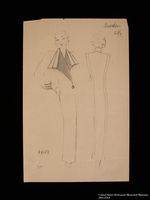
Coat design, Dresden, created by a German Jewish man and saved by his wife in hiding
Object
Original design for a coat created by Julius Isaacsohn, a Jewish designer with his own garment making business in prewar Berlin, Germany. In 1938, Julius and his wife Gertrud, a dressmaker with her own business, had lost their livelihood because of the anti-Semitic policies of the Nazi regime. They sent their daughter Dorit, age 6, to Brussels, Belgium, in early 1939, to stay with Gertrud’s sister Anna Kaufman. Germany invaded Belgium in May 1940, and Gertrud and Julius had Dorit returned to them in 1941. Gertrud and Julius became forced laborers for the German government, working in a leather factory and lumber yard respectively. On February 27, 1943, the family had to separate in order to go into hiding. Julius and Dorit stayed with family friends and Julius’ nephew, Rolf Isaacsohn, in Berlin, while Gertrud began working as a traveling seamstress. In October 1943, Gertrud brought Dorit to live with her on a farm in Wilkersdorf. Shortly after, Julius, who was hiding with friends, was betrayed to the authorities by Rolf. On October 29, Julius was deported to Auschwitz-Birkenau killing center in German-occupied Poland, where he was killed. Gertrud and Dorit traveled around eastern Germany making dresses for private clients until January 1945, when they were liberated by Soviet forces in Wilkersdorf. Gertrud and Dorit immigrated to the United States in November 1949.

Coat design created by a German Jewish man and saved by his wife in hiding
Object
Original design for a coat created by Julius Isaacsohn, a Jewish designer with his own garment making business in prewar Berlin, Germany. In 1938, Julius and his wife Gertrud, a dressmaker with her own business, had lost their livelihood because of the anti-Semitic policies of the Nazi regime. They sent their daughter Dorit, age 6, to Brussels, Belgium, in early 1939, to stay with Gertrud’s sister Anna Kaufman. Germany invaded Belgium in May 1940, and Gertrud and Julius had Dorit returned to them in 1941. Gertrud and Julius became forced laborers for the German government, working in a leather factory and lumber yard respectively. On February 27, 1943, the family had to separate in order to go into hiding. Julius and Dorit stayed with family friends and Julius’ nephew, Rolf Isaacsohn, in Berlin, while Gertrud began working as a traveling seamstress. In October 1943, Gertrud brought Dorit to live with her on a farm in Wilkersdorf. Shortly after, Julius, who was hiding with friends, was betrayed to the authorities by Rolf. On October 29, Julius was deported to Auschwitz-Birkenau killing center in German-occupied Poland, where he was killed. Gertrud and Dorit traveled around eastern Germany making dresses for private clients until January 1945, when they were liberated by Soviet forces in Wilkersdorf. Gertrud and Dorit immigrated to the United States in November 1949.

Coat design, Ibsen, created by a German Jewish man and saved by his wife in hiding
Object
Original design for a coat created by Julius Isaacsohn, a Jewish designer with his own garment making business in prewar Berlin, Germany. In 1938, Julius and his wife Gertrud, a dressmaker with her own business, had lost their livelihood because of the anti-Semitic policies of the Nazi regime. They sent their daughter Dorit, age 6, to Brussels, Belgium, in early 1939, to stay with Gertrud’s sister Anna Kaufman. Germany invaded Belgium in May 1940, and Gertrud and Julius had Dorit returned to them in 1941. Gertrud and Julius became forced laborers for the German government, working in a leather factory and lumber yard respectively. On February 27, 1943, the family had to separate in order to go into hiding. Julius and Dorit stayed with family friends and Julius’ nephew, Rolf Isaacsohn, in Berlin, while Gertrud began working as a traveling seamstress. In October 1943, Gertrud brought Dorit to live with her on a farm in Wilkersdorf. Shortly after, Julius, who was hiding with friends, was betrayed to the authorities by Rolf. On October 29, Julius was deported to Auschwitz-Birkenau killing center in German-occupied Poland, where he was killed. Gertrud and Dorit traveled around eastern Germany making dresses for private clients until January 1945, when they were liberated by Soviet forces in Wilkersdorf. Gertrud and Dorit immigrated to the United States in November 1949.
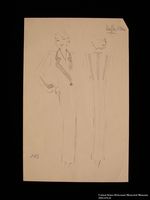
Coat design, Jaffa/ Ilse, created by a German Jewish man and saved by his wife in hiding
Object
Original design for a coat created by Julius Isaacsohn, a Jewish designer with his own garment making business in prewar Berlin, Germany. In 1938, Julius and his wife Gertrud, a dressmaker with her own business, had lost their livelihood because of the anti-Semitic policies of the Nazi regime. They sent their daughter Dorit, age 6, to Brussels, Belgium, in early 1939, to stay with Gertrud’s sister Anna Kaufman. Germany invaded Belgium in May 1940, and Gertrud and Julius had Dorit returned to them in 1941. Gertrud and Julius became forced laborers for the German government, working in a leather factory and lumber yard respectively. On February 27, 1943, the family had to separate in order to go into hiding. Julius and Dorit stayed with family friends and Julius’ nephew, Rolf Isaacsohn, in Berlin, while Gertrud began working as a traveling seamstress. In October 1943, Gertrud brought Dorit to live with her on a farm in Wilkersdorf. Shortly after, Julius, who was hiding with friends, was betrayed to the authorities by Rolf. On October 29, Julius was deported to Auschwitz-Birkenau killing center in German-occupied Poland, where he was killed. Gertrud and Dorit traveled around eastern Germany making dresses for private clients until January 1945, when they were liberated by Soviet forces in Wilkersdorf. Gertrud and Dorit immigrated to the United States in November 1949.
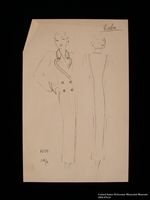
Coat design, Culm, created by a German Jewish man and saved by his wife in hiding
Object
Original design for a coat created by Julius Isaacsohn, a Jewish designer with his own garment making business in prewar Berlin, Germany. In 1938, Julius and his wife Gertrud, a dressmaker with her own business, had lost their livelihood because of the anti-Semitic policies of the Nazi regime. They sent their daughter Dorit, age 6, to Brussels, Belgium, in early 1939, to stay with Gertrud’s sister Anna Kaufman. Germany invaded Belgium in May 1940, and Gertrud and Julius had Dorit returned to them in 1941. Gertrud and Julius became forced laborers for the German government, working in a leather factory and lumber yard respectively. On February 27, 1943, the family had to separate in order to go into hiding. Julius and Dorit stayed with family friends and Julius’ nephew, Rolf Isaacsohn, in Berlin, while Gertrud began working as a traveling seamstress. In October 1943, Gertrud brought Dorit to live with her on a farm in Wilkersdorf. Shortly after, Julius, who was hiding with friends, was betrayed to the authorities by Rolf. On October 29, Julius was deported to Auschwitz-Birkenau killing center in German-occupied Poland, where he was killed. Gertrud and Dorit traveled around eastern Germany making dresses for private clients until January 1945, when they were liberated by Soviet forces in Wilkersdorf. Gertrud and Dorit immigrated to the United States in November 1949.
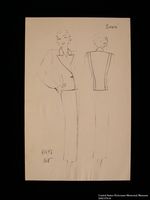
Jacket design, Gussi, created by a German Jewish man and saved by his wife in hiding
Object
Original design for a jacket created by Julius Isaacsohn, a Jewish designer with his own garment making business in prewar Berlin, Germany. In 1938, Julius and his wife Gertrud, a dressmaker with her own business, had lost their livelihood because of the anti-Semitic policies of the Nazi regime. They sent their daughter Dorit, age 6, to Brussels, Belgium, in early 1939, to stay with Gertrud’s sister Anna Kaufman. Germany invaded Belgium in May 1940, and Gertrud and Julius had Dorit returned to them in 1941. Gertrud and Julius became forced laborers for the German government, working in a leather factory and lumber yard respectively. On February 27, 1943, the family had to separate in order to go into hiding. Julius and Dorit stayed with family friends and Julius’ nephew, Rolf Isaacsohn, in Berlin, while Gertrud began working as a traveling seamstress. In October 1943, Gertrud brought Dorit to live with her on a farm in Wilkersdorf. Shortly after, Julius, who was hiding with friends, was betrayed to the authorities by Rolf. On October 29, Julius was deported to Auschwitz-Birkenau killing center in German-occupied Poland, where he was killed. Gertrud and Dorit traveled around eastern Germany making dresses for private clients until January 1945, when they were liberated by Soviet forces in Wilkersdorf. Gertrud and Dorit immigrated to the United States in November 1949.
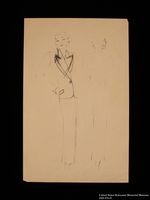
Unfinished jacket design created by a German Jewish man and saved by his wife in hiding
Object
Original, unfinished design for a jacket created by Julius Isaacsohn, a Jewish designer with his own garment making business in prewar Berlin, Germany. In 1938, Julius and his wife Gertrud, a dressmaker with her own business, had lost their livelihood because of the anti-Semitic policies of the Nazi regime. They sent their daughter Dorit, age 6, to Brussels, Belgium, in early 1939, to stay with Gertrud’s sister Anna Kaufman. Germany invaded Belgium in May 1940, and Gertrud and Julius had Dorit returned to them in 1941. Gertrud and Julius became forced laborers for the German government, working in a leather factory and lumber yard respectively. On February 27, 1943, the family had to separate in order to go into hiding. Julius and Dorit stayed with family friends and Julius’ nephew, Rolf Isaacsohn, in Berlin, while Gertrud began working as a traveling seamstress. In October 1943, Gertrud brought Dorit to live with her on a farm in Wilkersdorf. Shortly after, Julius, who was hiding with friends, was betrayed to the authorities by Rolf. On October 29, Julius was deported to Auschwitz-Birkenau killing center in German-occupied Poland, where he was killed. Gertrud and Dorit traveled around eastern Germany making dresses for private clients until January 1945, when they were liberated by Soviet forces in Wilkersdorf. Gertrud and Dorit immigrated to the United States in November 1949.
Coat design, Basel, created by a German Jewish man and saved by his wife in hiding
Object
Original design for a coat created by Julius Isaacsohn, a Jewish designer with his own garment making business in prewar Berlin, Germany. In 1938, Julius and his wife Gertrud, a dressmaker with her own business, had lost their livelihood because of the anti-Semitic policies of the Nazi regime. They sent their daughter Dorit, age 6, to Brussels, Belgium, in early 1939, to stay with Gertrud’s sister Anna Kaufman. Germany invaded Belgium in May 1940, and Gertrud and Julius had Dorit returned to them in 1941. Gertrud and Julius became forced laborers for the German government, working in a leather factory and lumber yard respectively. On February 27, 1943, the family had to separate in order to go into hiding. Julius and Dorit stayed with family friends and Julius’ nephew, Rolf Isaacsohn, in Berlin, while Gertrud began working as a traveling seamstress. In October 1943, Gertrud brought Dorit to live with her on a farm in Wilkersdorf. Shortly after, Julius, who was hiding with friends, was betrayed to the authorities by Rolf. On October 29, Julius was deported to Auschwitz-Birkenau killing center in German-occupied Poland, where he was killed. Gertrud and Dorit traveled around eastern Germany making dresses for private clients until January 1945, when they were liberated by Soviet forces in Wilkersdorf. Gertrud and Dorit immigrated to the United States in November 1949.
Coat design, Mia, created by a German Jewish man and saved by his wife in hiding
Object
Original design for a coat created by Julius Isaacsohn, a Jewish designer with his own garment making business in prewar Berlin, Germany. In 1938, Julius and his wife Gertrud, a dressmaker with her own business, had lost their livelihood because of the anti-Semitic policies of the Nazi regime. They sent their daughter Dorit, age 6, to Brussels, Belgium, in early 1939, to stay with Gertrud’s sister Anna Kaufman. Germany invaded Belgium in May 1940, and Gertrud and Julius had Dorit returned to them in 1941. Gertrud and Julius became forced laborers for the German government, working in a leather factory and lumber yard respectively. On February 27, 1943, the family had to separate in order to go into hiding. Julius and Dorit stayed with family friends and Julius’ nephew, Rolf Isaacsohn, in Berlin, while Gertrud began working as a traveling seamstress. In October 1943, Gertrud brought Dorit to live with her on a farm in Wilkersdorf. Shortly after, Julius, who was hiding with friends, was betrayed to the authorities by Rolf. On October 29, Julius was deported to Auschwitz-Birkenau killing center in German-occupied Poland, where he was killed. Gertrud and Dorit traveled around eastern Germany making dresses for private clients until January 1945, when they were liberated by Soviet forces in Wilkersdorf. Gertrud and Dorit immigrated to the United States in November 1949.



